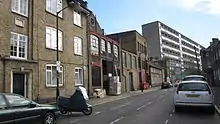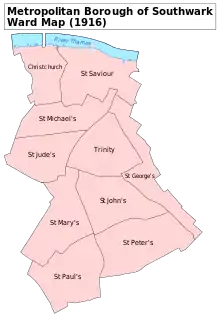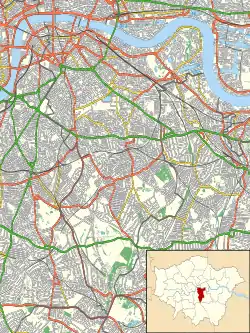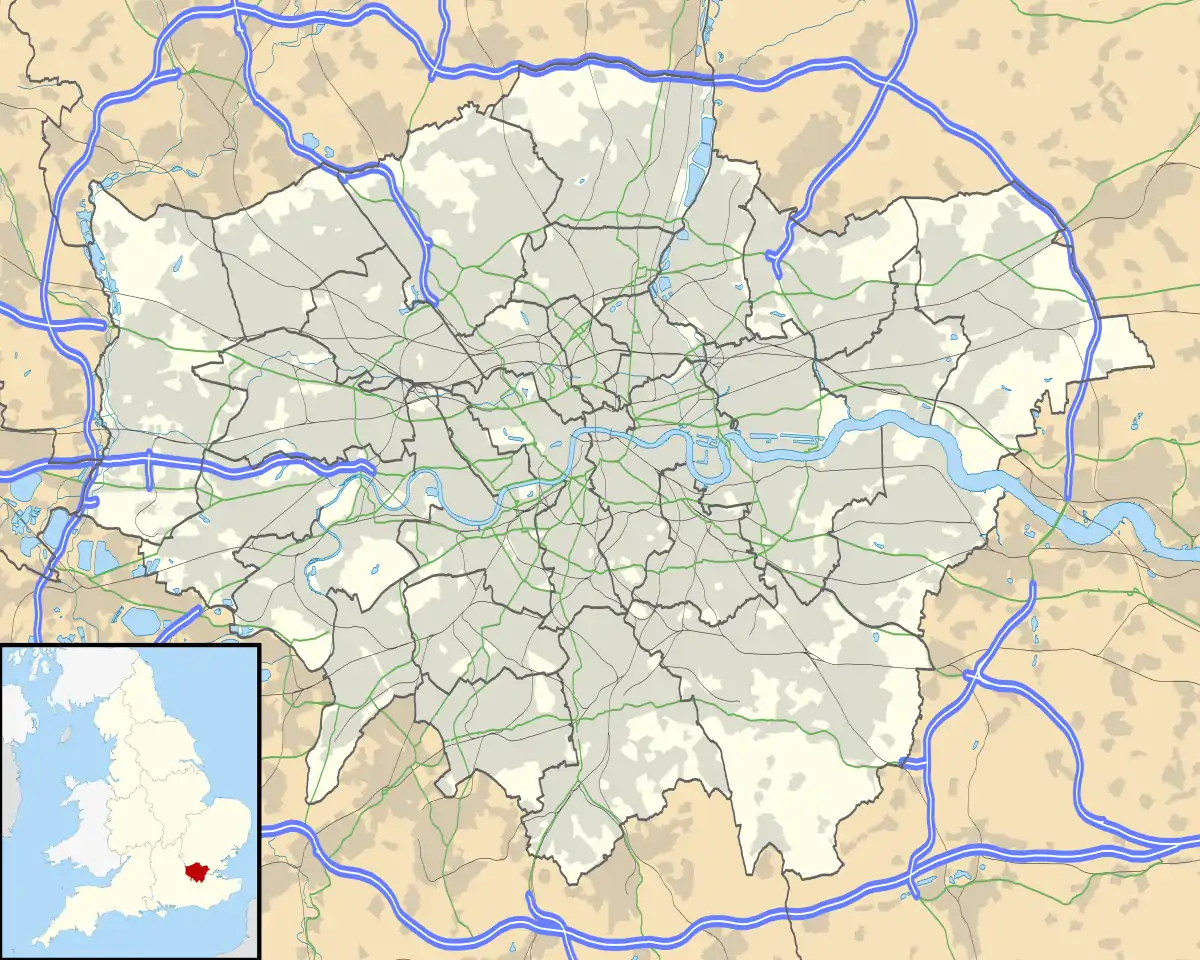Walworth
Walworth (/ˈwɔːlwərθ/) is a district of south London, England, within the London Borough of Southwark. It adjoins Camberwell to the south and Elephant and Castle to the north, and is 1.9 miles (3.1 km) south-east of Charing Cross.
Major streets in Walworth include the Old Kent Road, New Kent Road and Walworth Road.
History
The name Walworth is probably derived from Old English Wealh "Briton" and the suffix -worth "homestead" or "enclosure" and, thus, "British farm".
Walworth appears in the Domesday Book of 1086 as Waleorde. It was held by Bainiard from Archbishop Lanfranc of Canterbury. Its domesday assets were: 3½ hides; one church, four ploughs, 8 acres (32,000 m2) of meadow. It rendered £3.[1]

John Smith House is on Walworth Road, and was renamed in memory of John Smith, who was leader of the Labour Party from 1992 up to his sudden death in 1994. A former headquarters of the Labour Party, it was often seen in news reports at election times and in the background as people came and went from meetings of the Labour Party National Executive Committee. It was used by the London Borough of Southwark as the home for its education department and reopened in July 2012 as a hostel.[2] St Peter's Church, Walworth, built circa 1825, is an excellent example of the neo-classical style of church built by Sir John Soane. It is an indication of the wealth of the middle-class merchants who then lived in the vicinity that they could afford an architect of such prominence. Charles Upfold was born at Walworth Common and baptised at St. Peters. The church is home to the Monkey Gardens - which was once home to a menagerie kept by a past Reverend of the Church, but is now a garden.
Manor Place Baths is a former wash house in Manor Place off Walworth Road. It is a grade II listed building. The building was renovated by Kagyu Samye Dzong, Tibetan Buddhist Centre who obtained a five-year lease in 2005. They opened it as their London centre, called Manor Place Samye Dzong on 17 March 2007. Adjacent is the Council's old recycling depot which is now closed and has been replaced by a new facility[3] at 43 Devon Street, off Old Kent Road.[4]
Walworth is also home to the Pullens buildings - a mixture of Victorian live/work spaces and yards. Many of the flats are 1 bedroom, and some of the flats still connect to the Workshops of any of the three yards (Illife Yard, Peacock Yard and one other). They all share communal roof terraces with extensive views over to the West End.
Walworth also used to have a zoo, in Royal Surrey Gardens, which was visited by Queen Victoria.[5]
East Street market is a major street market. There are plenty of parks in the area, including:
- Michael Faraday Park
- Salisbury Row Park
- Nursery Row Park
- Burgess Park
- Victory Park
Politics

Walworth is made up of three wards - East Walworth, Newington and Faraday. All of the nine councillors for Walworth, are from the Labour Party.
Regeneration
Large amounts of regeneration and gentrification are occurring in Walworth, including the proposed demolition of the Elephant and Castle Shopping Centre, the newly built Strata tower, the demolition and regeneration of the Heygate and Aylesbury Estates, and redevelopment of St Mary's Churchyard as a new park. The Bakerloo Line Extension is planned to complete in 2028/29; two new stations are being built for it along Old Kent Road.[6]
Mentions in culture
The district of Walworth features in Charles Dickens’ Great Expectations; Mr Wemmick resides here in a small wooden cottage.
Walworth is featured in the 2016 novel by Stella Duffy, London Lies Beneath, set in 1912.[7] It is also featured in the 2017 film The Foreigner, as the restaurant of the protagonist Ngoc Minh Quan is based in this district.
Notable residents
- Charles Babbage[8]
- Bill Bailey
- William Booth, founder of The Salvation Army. 1 Kennington Row, Kennington Common.
- Robert Browning
- Sir Charlie Chaplin, born 1889, actor and director[9]
- Sir Michael Caine, actor
- Michael Faraday
- Alan Ford, actor, born here in 1938
- Samuel Palmer[10]
- John Ruskin
- Frank Stubbs, recipient of the Victoria Cross, born December 3, 1888[11]
- Charles Upfold[12]
- The Walworth Jumpers, a 19th century religious movement[13]
Transport and locale
Nearest places
Nearest underground station
- Elephant & Castle (Bakerloo and Northern lines)
Nearest National Rail station
References
- Surrey Domesday Book Archived 30 October 2007 at the Wayback Machine
- Safestay to open in Elephant & Castle, London, SE17 Safestay, 5 March 2012
- http://www.southwark.gov.uk/info/533/waste_management_facility
- Kagyu Samye Dzong London at Manor Place Kagyu Samye Dzong London
- Whelan, John (2017). "The History of Walworth Garden". Walworth Garden. Retrieved 8 December 2019.
- Bakerloo line extension - Have your say TFL, 15 February 2017
- Review: Stella Duffy, What Lies Beneath, The Guardian, 20 October 2016
- Swade, Doron. "Babbage, Charles". Oxford Dictionary of National Biography (online ed.). Oxford University Press. doi:10.1093/ref:odnb/962. (Subscription or UK public library membership required.)
- "Charlie Chaplin - Walworth Road". London Remembers. Retrieved 18 September 2018.
- Shaw-Miller, Simon (5 July 2017). Samuel Palmer Revisited. Routledge. ISBN 978-1-351-55015-4.
- "Frank E Stubbs VC - victoriacross". www.vconline.org.uk. Retrieved 18 September 2018.
- "Charles Upfold (1834 - 1919)". ancestry.co.uk. Retrieved 10 December 2020.
- Davies, Charles Maurice (1874). Unorthodox London, Or, Phases of Religious Life in the Metropolis. Tinsley Bros.
External links
 Media related to Walworth, London at Wikimedia Commons
Media related to Walworth, London at Wikimedia Commons- Southwark Notes – whose regeneration? Regeneration and Gentrification in Southwark, South London



